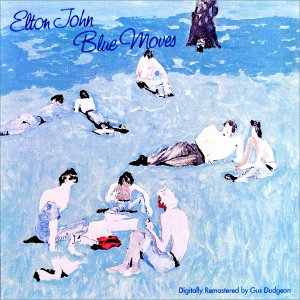
"Blue Moves" (1976) Was One Of The Moodiest Albums Of Elton John's Career, And Something Entirely Removed From "Goodbye Yellow Brick Road" (The Only Other Double Album He Ever Issued)
When being interviewed in 1991, Elton John remarked that he had not released a good album ever since 1976’s “Blue Moves”. He also termed it an album where he did absolutely what he wanted to do. He went to say that he wasn’t really thinking about pleasing anybody but himself, to come up with a record that he would like to listen afterwards. That might go some way into explaining why the double album yielded virtually no hit singles (“Sorry Seems To Be The Hardest Word” was the lone exception, peaking at #6) and why it would take time for “Blue Moves” to grew into stature until it became one of his most respected works among critics and fans alike.
Certainly, if we were to compare “Blue Moves” with the only other double album Elton issued in his career (1973’s “Goodbye Yellow Brick Road”) the difference is entirely apparent. “Goodbye Yellow Brick Road” was an album for everybody, or (rather) an album where Elton performed in ways everybody was sure to appreciate. It was to become his most representative work to the public at large, and a true embodiment of every facet that defined his classic years. It was pop music at his best, and the way in which he approached issues like mortality and transience (“Funeral For A Friend/Love Lies Bleeding”, “Candle In The Wind”…) did attenuate the gravity at play. If anything, the music was so full of life that he could sing about just anything (“Social Disease”) and get away with it. A truly negative connotation could only surface if you looked for it, and if you looked for it in an extensive way at that.
On the contrary, “Blue Moves” was an album in which you could read negativity at every turn. Because it was an album where Elton clearly spoke to himself. There are fewer examples of John’s music sounding this introspective. And when it did, Elton was singing about a character (“Captain Fantastic & The Brown Dirt Cowboy”). Here, you listen to him in the most direct and unstripped setting. No wonder “Goodbye Yellow Brick Road” was critically acclaimed from the beginning, and “Blue Moves” could only be appreciated in retrospective.
The band he used for “Blue Moves” was the same band that he had employed on “Rock Of The Westies”. “Blue Moves” was to mark the final studio performance by this new unit, although many of the musicians (most notably James Newton-Howard and Ray Cooper) would remain close associates. And Davey is still there to this day, of course.
The album has a strong (and meaningful) start in the shape of “Tonight”, with arguably James Newton-Howard’s best orchestral contribution to any album by Elton John. The orchestra plays for three solid minutes alongside Elton during the intro, and then it comes back after the first verse to wring even more destitution out of a truly heartbroken composition. As a performance, this version of “Tonight” is devastating. But for the definitive rendition of the song you should listen to the “Live In Australia With The Melbourne Symphony Orchestra” album (1987). There, the raggedness of Elton’s voice is a violent reminder to everybody of the life that he has led, and the price that he has had to pay, both personally and professionally during a decade that was actually complicated for every other ‘60 and ‘70s performer that was still around.
(Note that “Tonight” is not the first cut on the album; “Blue Moves” actually starts with an instrumental that is entirely disposable named “Your Starter For…”, and the same goes for the other two that surface on the second disc, “Out Of The Blue” and “Theme For A Non-existent TV Series”.)
“Tonight” is followed by a track in which an old friend comes to say “hello” in the most vigorous way of all. “One Horse Town” is the sole true rocker of the whole album, and Paul Buckmaster was brought in to do his thing. And he was to sound wilder than ever, in a track in which Elton’s voice isn’t really on. Everything else is masterful, and Buckmaster’s arrangement frees Caleb Quaye to provide one his most impressive solo to an EJ composition. Later on, Elton was to say that Quaye (who left after touring the album and is now a Ministry) was the true standout performer within his camp. Tracks like “One Horse Town” can certainly be used to back that up. And (personally) I like the way Caleb and Quaye complemented each other this time around. That fluidity was not around on “Rock Of The Westies”, and I said as much in my original review. But things were beginning to click on “Blue Moves”. History can’t ever be rewritten, but one just wonders what could the “new” Elton John band have achieved beyond this point had it stayed together.
Continue reading about the remaining songs on the second part of the review.

Pingback: Blue Moves (Elton John) – Album Review (Part 2) | MusicKO